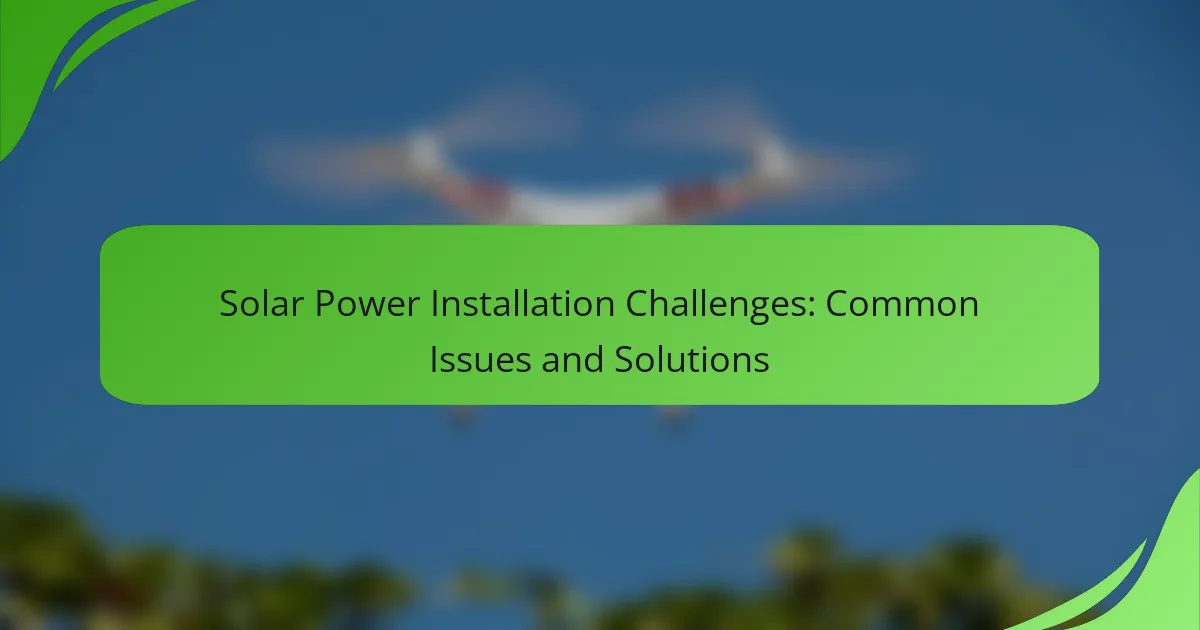Installing solar power systems presents unique challenges, particularly in urban settings where space is limited and regulations are stringent. By understanding these obstacles and employing effective strategies, homeowners can navigate the installation process more smoothly and maximize the benefits of solar energy. Additionally, considering financial aspects such as initial costs and available incentives is essential for making informed decisions about solar investments.
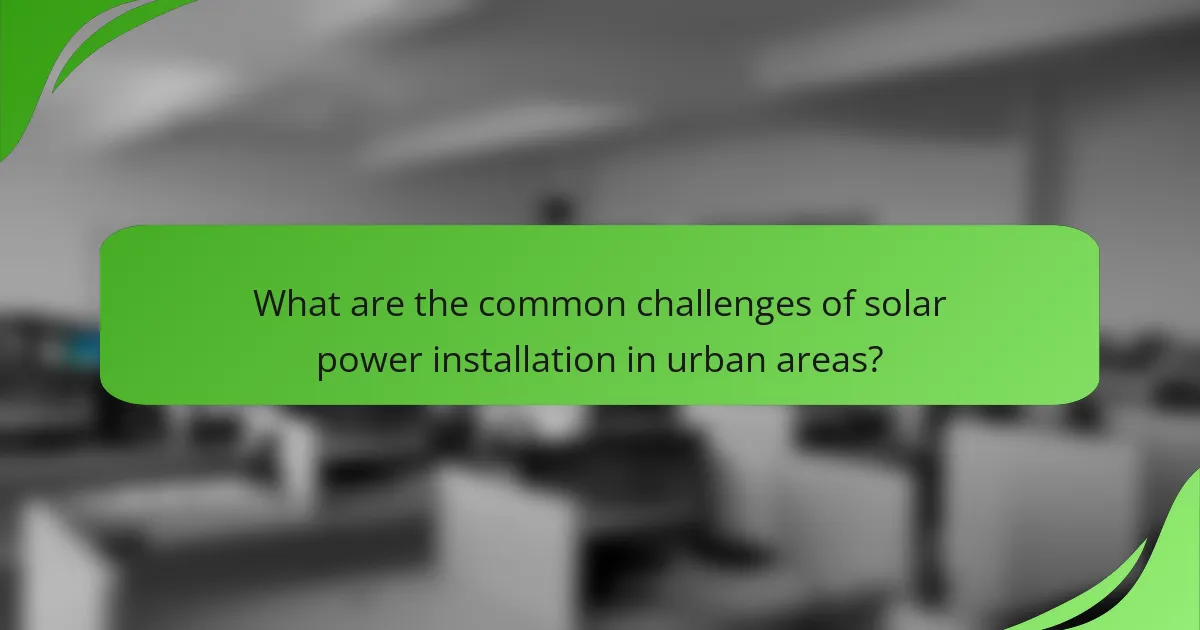
What are the common challenges of solar power installation in urban areas?
Solar power installation in urban areas faces several challenges, including limited space, strict building codes, and access to sunlight. Addressing these issues is crucial for successful solar projects in densely populated environments.
Space limitations
Urban environments often have restricted roof space, which can limit the size and number of solar panels that can be installed. Many buildings may not have flat roofs or sufficient area to accommodate a full solar array.
To maximize efficiency, consider using solar panels that offer higher wattage in smaller sizes or explore vertical installations. Rooftop gardens or green roofs can also be integrated to optimize space usage.
Building codes and regulations
Compliance with local building codes and regulations is essential for solar installations in urban areas. These codes can dictate the type of materials used, installation methods, and even aesthetic considerations.
Before proceeding, check with local authorities to understand the specific regulations that apply to your project. Engaging with a professional installer familiar with local codes can help navigate these requirements effectively.
Access to sunlight
In urban settings, tall buildings and structures can obstruct sunlight, reducing the efficiency of solar panels. This shading can significantly impact energy production, especially during peak sunlight hours.
Conduct a solar site assessment to evaluate potential shading issues. If shading is a concern, consider installing panels in areas with better exposure or using solar technologies that perform well in partial shade.
Structural integrity of rooftops
Before installation, it is crucial to assess the structural integrity of rooftops to ensure they can support the weight of solar panels and mounting systems. Older buildings may require reinforcement to handle this additional load.
Engage a structural engineer to evaluate the roof’s condition and recommend any necessary upgrades. This step can prevent costly repairs and ensure the safety of the installation.
Electrical system compatibility
Compatibility between the solar power system and existing electrical infrastructure is vital for successful integration. Older electrical systems may not support the additional load or require upgrades to accommodate solar energy production.
Consult with a qualified electrician to assess your current electrical system. They can help determine if any modifications are needed to ensure safe and efficient operation of the solar installation.
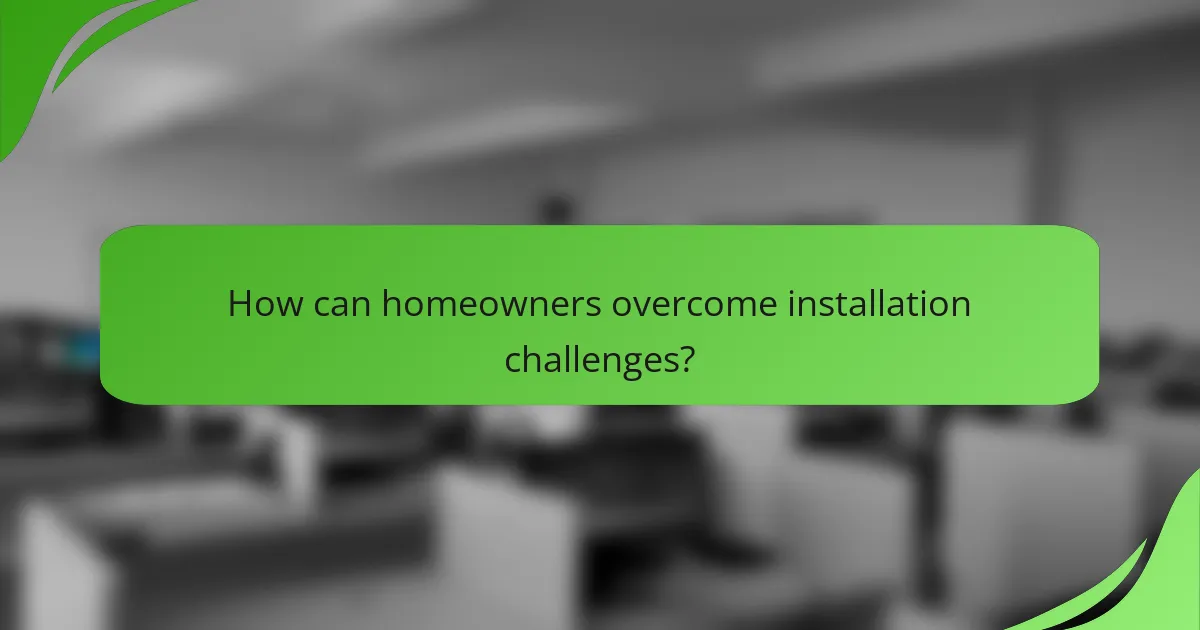
How can homeowners overcome installation challenges?
Homeowners can effectively tackle solar power installation challenges by seeking professional guidance, conducting thorough assessments, selecting appropriate technology, and exploring financing options. These strategies help ensure a smoother installation process and maximize the benefits of solar energy.
Consulting with solar experts
Engaging with solar experts is crucial for homeowners facing installation challenges. Professionals can provide insights into local regulations, installation best practices, and potential pitfalls. They can also recommend reputable contractors who specialize in solar energy systems.
Homeowners should seek consultations from multiple experts to compare advice and pricing. This approach helps in making informed decisions and avoiding costly mistakes during the installation process.
Conducting site assessments
A comprehensive site assessment is essential to identify the best solar installation options. This evaluation considers factors such as roof orientation, shading from trees or buildings, and structural integrity. Homeowners should ensure their roofs can support the weight and installation of solar panels.
Additionally, a site assessment can help determine the optimal size and type of solar system needed to meet energy demands. This step can prevent future issues related to insufficient energy production or system inefficiencies.
Choosing the right solar technology
Selecting the appropriate solar technology is vital for maximizing energy efficiency and cost-effectiveness. Homeowners can choose between different types of solar panels, such as monocrystalline, polycrystalline, and thin-film, each with its own advantages and drawbacks.
Considerations include efficiency rates, space availability, and budget. For example, monocrystalline panels are typically more efficient but may come at a higher cost, while polycrystalline panels offer a more affordable option with slightly lower efficiency.
Utilizing financing options
Exploring financing options can significantly ease the financial burden of solar installations. Homeowners can consider various methods, including solar loans, leases, and power purchase agreements (PPAs), each offering different benefits and commitments.
Many states and local governments also provide incentives, tax credits, or rebates that can reduce upfront costs. Homeowners should research available programs in their area to maximize savings and make solar energy more accessible.

What are the financial implications of solar power installation?
The financial implications of solar power installation encompass initial costs, potential long-term savings, and available government incentives. Understanding these factors is crucial for evaluating the overall investment and return on solar energy systems.
Initial investment costs
The initial investment for solar power installation typically includes the cost of solar panels, inverters, mounting equipment, and installation labor. Depending on the system size and location, these costs can range from several thousand to tens of thousands of dollars. Homeowners should also consider additional expenses such as permits and inspections.
Financing options, such as solar loans or leases, can help mitigate upfront costs. It’s essential to compare these options to determine which aligns best with your financial situation and long-term goals.
Long-term savings on energy bills
Investing in solar power can lead to significant long-term savings on energy bills. Once installed, solar panels generate electricity at little to no cost, reducing reliance on grid power. Many homeowners report savings of 50% or more on their monthly utility bills.
Additionally, the savings can increase over time as electricity rates rise. Evaluating your local energy prices and potential solar production can help estimate future savings accurately.
Government incentives and rebates
Government incentives and rebates can significantly offset the cost of solar power installation. In many regions, federal and state programs offer tax credits, grants, or rebates for solar energy systems. For instance, in the United States, the federal solar tax credit allows homeowners to deduct a percentage of the installation costs from their federal taxes.
It’s important to research local incentives, as they can vary widely. Some states and municipalities offer additional financial support, making solar installation more affordable. Always check the eligibility requirements and application processes to maximize your benefits.
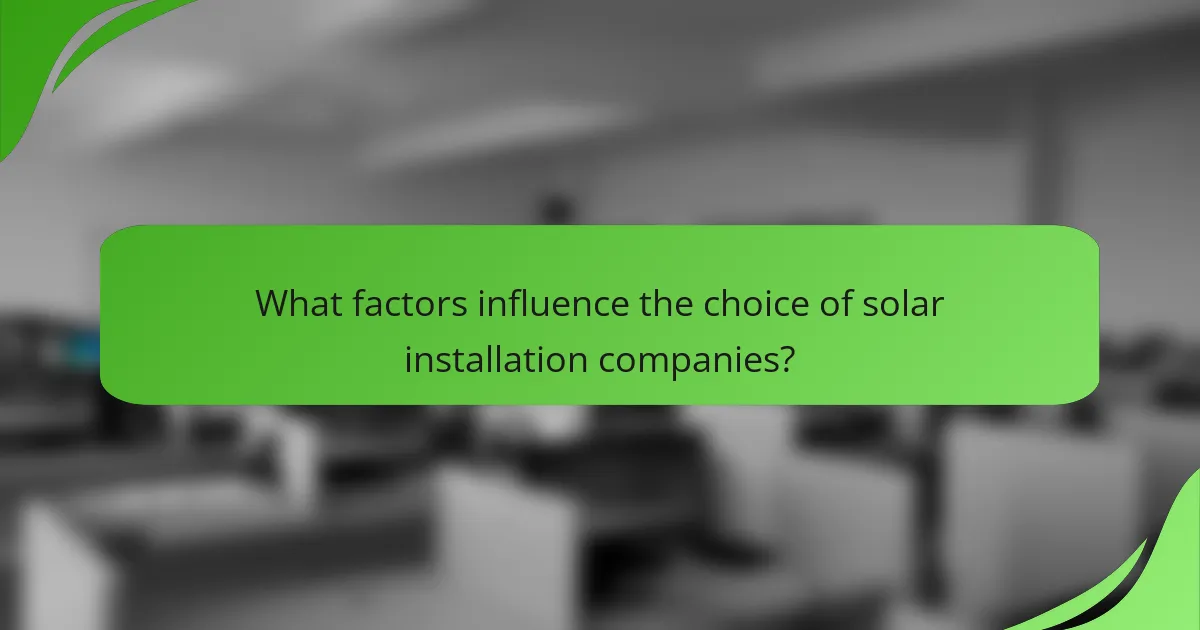
What factors influence the choice of solar installation companies?
Several factors influence the choice of solar installation companies, including their experience, customer feedback, and warranty offerings. Evaluating these aspects can help ensure a reliable and effective solar power system installation.
Experience and reputation
Experience and reputation are critical when selecting a solar installation company. Companies with several years in the industry typically have a proven track record, which can indicate reliability and expertise. Look for firms that have completed numerous installations and have a solid standing within the community.
Check if the company has experience with the specific type of solar technology you are considering, such as photovoltaic (PV) systems or solar thermal systems. A reputable company should also be familiar with local regulations and incentives, which can vary significantly by region.
Customer reviews and testimonials
Customer reviews and testimonials provide valuable insights into the quality of service a solar installation company offers. Look for feedback on platforms like Google, Yelp, or specialized solar review sites. Positive reviews often highlight professionalism, timeliness, and post-installation support.
Consider reaching out to past customers directly for their experiences. Ask about the installation process, any challenges faced, and how effectively the company addressed those issues. This firsthand information can be crucial in making an informed decision.
Warranty and service agreements
Warranty and service agreements are essential components to consider when choosing a solar installation company. A strong warranty typically covers the solar panels, inverter, and installation workmanship, often lasting 20-25 years for panels and 5-10 years for labor. Ensure the terms are clear and comprehensive.
In addition to warranties, inquire about service agreements that may include maintenance and monitoring services. Regular maintenance can enhance system performance and longevity, making it a worthwhile consideration when evaluating potential companies.
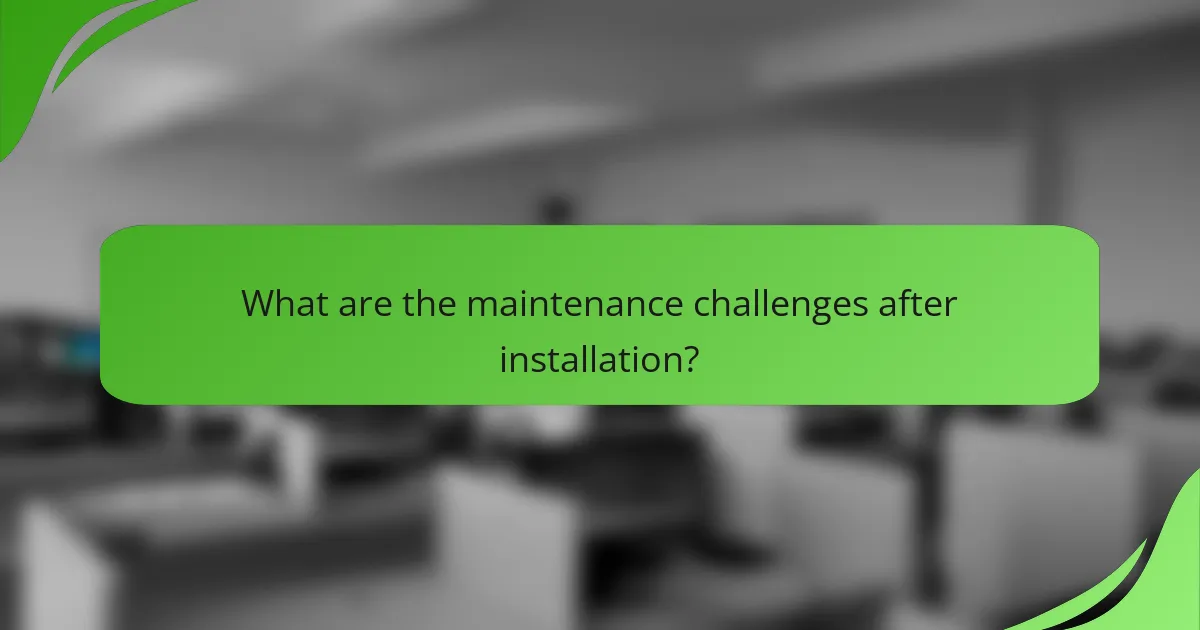
What are the maintenance challenges after installation?
Maintenance challenges after solar power installation primarily involve ensuring optimal performance and longevity of the system. Regular upkeep is essential to address issues such as dirt accumulation, system monitoring, and technical malfunctions.
Regular cleaning of solar panels
Solar panels require regular cleaning to maintain efficiency, as dirt, dust, and debris can significantly reduce their energy production. Depending on the local environment, cleaning may be needed every few months or more frequently in dusty areas.
Homeowners can clean panels themselves using a soft brush and water, or hire professional services. It’s crucial to avoid harsh chemicals that could damage the panels.
Monitoring system performance
Monitoring the performance of solar systems is vital for identifying issues early. Many systems come with built-in monitoring tools that track energy production and alert users to any drops in efficiency.
Regularly checking performance metrics can help in understanding whether the system is operating at expected levels. If performance dips below a certain threshold, further investigation may be necessary.
Addressing technical issues
Technical issues can arise in solar power systems, including inverter failures or electrical faults. It’s important to have a qualified technician conduct regular inspections to identify and resolve these problems promptly.
Homeowners should familiarize themselves with common signs of malfunction, such as unusual noises or error messages on the inverter display. Prompt action can prevent more extensive damage and costly repairs.
